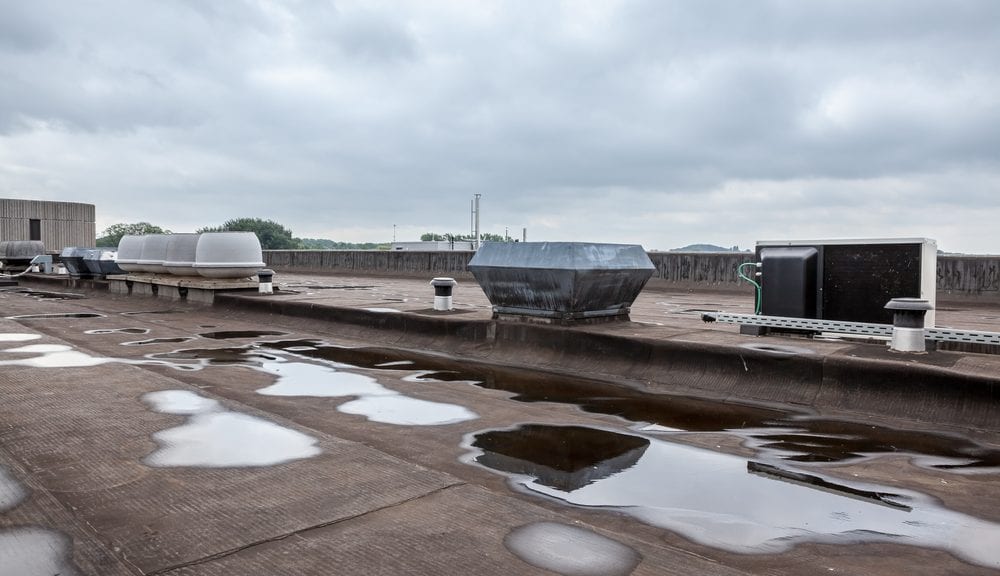Your commercial building’s roof has a lot of enemies, including harsh weather, time, and even human error. Obviously, storm damage to your roof is a major concern in the current spring and upcoming summer months (see our previous post on what you can do to protect your roof from that type of damage), but less extreme threats are also working against the integrity of your roof.
The following top four most common causes of commercial roofing problems may surprise you, but the good news is that you can work to alleviate damage to your roof with simple checks, or just a phone call to Heidler Roofing at 717-792-3549 (York, PA) or 301-766-4030 (Hagerstown, MD) to talk about maintenance options.
1. Standing Water/Ponding
Does your building have a flat or nearly flat roof? If so, you may have low spots where water collects after rain and “ponds,” which means it doesn’t drain away or evaporate quickly. Standing water on your roof can contribute to a number of costly problems for your building as the roofing material is damaged and more rapidly deteriorates versus its expected lifespan. Among other problems, water can eat away at the adhesives used in the construction of common flat roofs, which, in turn, can allow moisture to infiltrate your building’s interior.
As we discussed in our previous blog post, 7 Signs You Need to Contact Your Roofing Contractor, moisture infiltration can lead to extremely serious problems for your building and your business operations such as mold growth or damage to interior walls, ceilings, and floors.
2. Age
While some things only get better with age, unfortunately, your building’s roof isn’t one of those. Natural aging of your roof can not be prevented, of course, so if it’s been many years since your roof’s installation, you should consider a basic assessment by a commercial roofing professional. Issues arise with splitting seams and shifting vents, among others, which lead to the dreaded infiltration of moisture or even holes in the roof. Further, if your building’s roof is very old, you may find that your insurance company will refuse to cover damage claims, and you may be left paying unexpected bills following severe weather events like wind or hail storms.
So, how long should your building’s roof last? That’s a complicated question that depends on your roof’s material and other factors. Often, your new roof will come with some type of warranty coverage that may be anywhere from 5 years to 30 years (or more) depending on the material used in its construction, who manufactured that material, and whether the building owner purchased a specific warranty plan. If you know your roof is no longer covered by any type of warranty, or you simply do not know the age of the roof at all, contact Heidler Roofing today; our experts can help determine the age and remaining lifespan of your building’s roof and prevent age-related problems before they start, or provide options for repair and replacement.
3. Mechanical Contractors
HVAC and other rooftop systems require regular maintenance and occasional repair work, but mechanical contractors and other workers accessing your roof don’t always clean up after themselves. There may be trash or leftover materials like excess lumber or metal items hiding out on your building’s roof, which could be attracting pests or simply leading to accelerated deterioration of the roofing material by holding moisture.
Did you recently have new equipment installed or an extensive rooftop project that required alteration of the roof in some way? If so, it’s possible that unseen damage was caused by workers, even unintentionally. There could be small holes in the roofing material or sections that were completely removed as part of the work, and it may not be easy to spot with just a casual check. Having a roofing professional assess changes made by other workers, either in person or through photos you may have taken, will help assure that issues created by human error do not escalate into major roof problems.
4. Debris
Natural debris like tree leaves and twigs, or manmade trash like cardboard or paper waste that has migrated out of nearby dumpsters, can clog your building’s rain gutters or simply accumulate in out-of-the-way areas and lead to more rapid deterioration of roofing materials, as mentioned above. It’s likely that you do not have staff members or outside contractors on your roof on a regular basis to clean up trash; however, regular inspections of your roof space for accumulated debris are important. Especially if severe weather recently occurred, your roof may be hosting lots of extraneous material that should not be there.
What You Can Do to Fix the Problems
As we’ve discussed here, preventative maintenance is the name of the game in terms of keeping your building’s roof problem-free. Checking for issues on your roof (at least seasonally, as well as immediately after extreme weather events such as storms with high winds), and quickly correcting things like ponding water and debris accumulation will keep your roof, and your building, from suffering potentially costly damage.
And did you know that during the current spring and upcoming warm weather months, it’s actually time to begin planning how to prepare your roof for next winter? Springtime preventative maintenance keeps your roof ready to handle the potential snow loads of the colder months, as well as gives you peace of mind for upcoming summer storm season.
Are you located in the mid-Atlantic region (PA, MD, DE, VA, WV, DC) and don’t have time or staff to perform inspections of your roof yourself? Or have you performed checks and found issues that need to be fixed ASAP? Get in touch with us now to talk about our maintenance programs or repair options.


